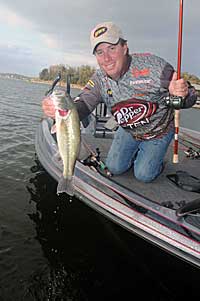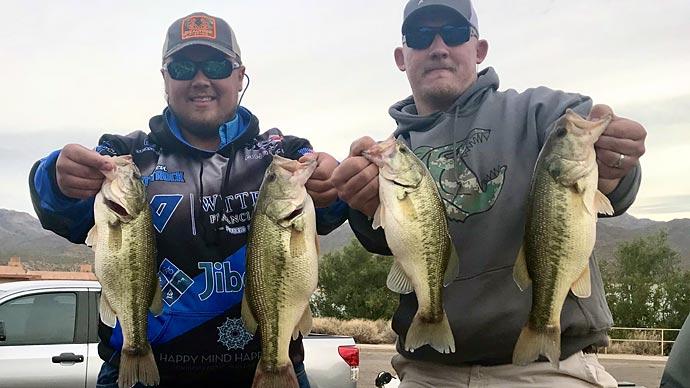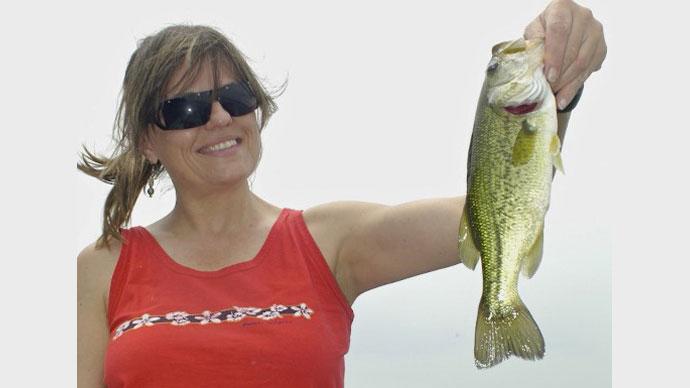
For years, decades really, there was no decision to be made. When you caught a fish, you kept it. In fresh water or salt, private water or public, the fish we caught got a free ride home, our home. Here they were guests of honor at dinner.
Today, we not only fish public waters with restrictive bag limits, we fish private ponds with an entirely different mind-set. Our pond fishing provides relaxation, recreation and a sense of accomplishment that comes with catching a fish raised by your hand, with lots of help from Mother Nature. For most thinking pond owners, food for the table is only a secondary, albeit tasty, happenstance.
Unfortunately, while many pondmeisters are beginning to think before they remove a fish, they often are removing the wrong fish. Fact is, fisheries consultants across the US. and Canada point out that the fish we take from a pond are just as important as the ones we allow to stay.
In the eye of this issue swims the predator we anglers seek, the largemouth bass or trout. Less often, the gamefish of choice will be large bluegill or specialty species such as the hybrid striped bass.
As the largest, most active meat-eaters in a small system, these fish control the population dynamics between prey and predator. As Mother Nature's traffic cop, they hold the trump card on which fish survive and in what number. Remove too many predators, and the smaller, less desirable species take over. With no wardens to hold them in check, the inmates run the asylum.
Bill Cody, a consultant with Aquatic Taxonomy Specialists in Malinta, OH known as The Pond Doctor, explains it this way: "Improper harvest of largemouth bass ruins future fishing in more ponds, probably in all states, than any other cause."
In new ponds, the first year is especially crucial. Ironically, that's when impatient pond owners hammer their bass. The American Fisheries Society produced documents in the 1960s that carried the same message: "Bass are frequently over-harvested in the first season of fishing.
"A pondowner can reduce the likelihood of bass over-harvest by making his pond off-limits to everyone. This should not be encouraged because underfishing can lead to about as many problems as overfishing.
Biologist Jason Roehrig of Inspired by Nature, quoting field surveys on harvest, said, "If I recall correctly, studies in Missouri show that ponds and lakes first open to fishing showed predator reductions of 33-to-69 percent in just the first three days of fishing. Taking this to the small pond level, an over-zealous fisherman can send a well balanced bass fishery spiraling out of control in a couple of hours."
Okay, so, to maintain a high-quality fishery, how many fish do we remove? And what size fish?
It depends, say the experts on the Pond Boss Field Advisory Staff. Harvest restrictions, often simply called bag limits, hinge on two things -- goals of the pond owner and productivity of the water.
Byron Bezdek, a fisheries consultant in Lisbon, OH, says a number of variables play into his recommendations, but "if the bass population has members in all size ranges fingerling to large breeders, it is in good shape," he said. "In practice, there is no hard-and-fast rule."
Cody said, "The amount of fish that can be produced or grown each year is based on the fertility or the ability of the water. The amount of fertility thus determines how much can be harvested."
In a new pond, Cody suggests that anglers not fish for largemouth for one full year after stocking, "This prevents losses even from (delayed mortality) handling during catch and release," he said. "Do not remove any bass until the third summer after stocking. That gives the first hatch time to mature enough to spawn. That way, if you remove any brood stock, they still have adequate numbers to provide young-of-the- year. The first stocked bass must support all bass harvest for three years after the first spawn.
"Be patient. Let nature work."
When it comes to the harvest of bass from an established fishery, the Field Advisory Staff seldom recommends taking no more than 15-to-20 pounds of adult bass per surface acre. That's only six or seven 3-pound bass per year, tops. In northern waters, where the growing season runs only from Easter to Labor Day, the magic harvest number might be only 10 pounds of bass per acre.
Veteran fisheries biologist Paul Dorsett of Total Lake Management in Byran, TX shys away from one-size-fits-all blanket policy for his clients. Instead, his recommendations vary pond to pond, according to the fertility of the water.
Good, fertile green water rich in plankton tends to produce more fish flesh per surface acre than a clear, sterile body of water the same size. Thus, even "sister" ponds that lie in the same watershed should have different bag limits.
"It's all based on a pond's productivity," Dorsett said. "I might recommend removing 10 pounds per surface acre for one client, but right down the road, another client could take up to 30 pounds without any problem."
There is, however, one certainty: Fish are finite in number. Clear water is less productive than more fertile water with a greenish tint.
"Even in a pond with good fertility, never harvest more than 20 bass, which would be 20 pounds or more, per surface acre, per year," Cody said. "Here is where keeping records is very helpful. Who can remember what has been caught?"
In a small system, the balance in the prey-predator relationship can be especially delicate.
"For every surface acre in a clear-water pond you might end up with only 4-to-5 pounds of predators and 40 pounds of forage," Cody said. "In fertile, naturally alkaline waters, the numbers might be 40 pounds of predators and 400 pounds of forage."
As many consultants point out to their pond-owning clients, the number of fish and their total weight (called "biomass") can be increased by proper fertilization of the water and feeding the fish with high-protein pellets. But as usual, there's a qualifying element: "You can't take out a lot of those fish and expect to have good fishing when you return," Cody said.
In theory, pond anglers should be able to harvest the same number of pounds of fish the pond produces each year. The pond, in that light, becomes a wheat field or a cotton patch. But there's a qualifier: The fish you harvest wind up determining the size structure in the fish population that remain. This is where the traffic cop analogy comes into play.
"You need to have a goal of what you want the dominant fish species to be, and what you hope their sizes will be," Cody said. "Once you have that objective, you can manage the populations toward that goal."
Let's look at several management options, and examine how selective harvest can help reach the target.
If, for instance, a pond owner would like to catch high numbers of fish, and size is not important, then no harvest restrictions need be set. Keep as many as you can eat.
Trouble is, as the pond ages, the quality of the fishing experience tends to decline. Small fish eventually will dominate, because anglers remove the larger, more desirable fish.
In working with pond owners across North America, we find that many readers and web site visitors want to catch a variety of fish, and they'd like to catch an occasional large fish.
"In an all-purpose fishery, most of the harvest will be 5-to-7 inch bluegill and bass that go 8-to-12 inches," Cody said. The management goal here should be to maintain large numbers of 12-to-15 inch bass that will control bluegill numbers and provide a good run on a medium-action fishing rod. Cody's recommendation: Impose a "slot limit" that will protect bass in the 12-to-15 inch class.
For pond owners who are juggling their management techniques with hopes of producing larger bass, Cody offers several observations:
- As population densities go up, the likelihood for top-end trophy size goes down.
- In waters north of the Mason-Dixon Line, a bass longer than 15 inches is a considered a trophy. In southern Georgia, for instance, a bass may reach 15 inches before it is 2 years old.
- Pond owners seldom keep detail records of their harvest. Thus, he does not tell clients to harvest a certain number of pounds per acre.
- Once a northern bass reaches 18 inches, it should under ideal conditions add one inch and one pound per year.
- Bass convert food at a rate of 10:1. Ten pounds of food for one pound of weight gain. To grow bigger fish, the pond owner must feed his forage base and/or reduce the competition for food or as Cody said, "thin out the brothers and sisters."
- Owing to climate restrictions of the Midwest, bass harvest must be carefully restricted because the number of big largemouth produced per acre in a pond is relatively low. Pond owners in East Texas need not be quite so restrictive. In any region, the selective harvest of small bass will improve the growth of those that remain.
- To keep panfish numbers in check, anglers should consider keeping most bluegill they catch.
- Certain lures, such as giant topwater lures, tend to be selective in the size bass they attract. Small in-line Mepps-style spinners tend to catch smaller fish and more of them. Do not be fooled. Fishing techniques can determine what size bass you catch, which may tend to sway your evaluation of the pond and its fish populations.
Trout ponds
Most ponds do not have reproducing populations of rainbow trout. This popular species is stocked, fed and harvested, then restocked. This pond to plate cycle repeats itself virtually coast to coast.
Scott Trava, a consultant for pond owners with property outside New York City. said, "Here in New York the state tells you to get two clean garbage cans. They fill up the cans, every year, if you need them."
The same is not true for brook and lake trout. Given adequate spawning cover and high water quality, these two may spawn in the wild.
In northern climes, the short growing season is an issue. The shorter the growing season, the more conservative should be the harvest.
Bluegill ponds
When bluegill are marquee species, Cody says pond owners are always tempted to lop off the population at the top. Give those mature fish a chance to do their jobs, consultants say.
"Be very careful not to over-harvest the large bluegill," Cody said. "Harvest mostly the mid-sized fish 5-to-8 inch range, and release all the fish greater than 8 or 9 inches long."
Bluegills pose a management challenge, says Bezdek, because they tend to overpopulate and they can wreak havoc on a bass population by raiding the spawning grounds.
When bluegill are not growing up to expectations, chances are they don't have enough food. That's where reducing the competition for the natural food supply comes in, or introducing high-protein feed pellets to increase the amount of food available.
Paul Dorsett says he seldom finds clients who are truly committed to doing what it takes to create a high-quality bluegill fishery.
"Most weekend recreational fishermen and women have a hard time catching and eating enough bluegill to maintain a quality "trophy" population of bluegills," he said. "To better understand we need to consider competition ... A bluegill-only population will produce many offspring with few predators. It does not take long for them to become stunted at around 3 inches."
Cody often encourages his clients to feed bluegill with floating pellets, with his eye on reaping multiple benefits.
"You usually have to feed pellets to keep the body mass up and growth going, especially if the fish are crowded because they overeat the natural food base," Cody said. "Put them on welfare and they ignore a lot of the natural food, simply because it takes more work to catch the live prey. The natural foods go free, which helps feed the fish that don't eat pellets."
Cody uses a shoreline feeder to add protein to natural forage base, yes, but also to help him decide how many bluegill could be removed without hampering the fishing.
"Harvest your bluegill according to the numbers you observe at feeding time," Cody said. "Feeding allows you to observe the population size structure of many of your fish.
Size of fish caught fishing also gives you a general, rough idea of what is in the pond - as long as you can get the little rascals to bite."
Ironically, when managing for bluegill, the pond owner must keep his (her) eye on the bass population. Cody figures that for every bass removed from the system, it leaves behind 8-to-10 pounds of uneaten bluegills, which are going to reproduce. Soon you have too many bluegills.
Cody, like many pond professionals, urges his clients to keep records of how many fish they catch, and their size.
"Keeping records of length and weight (or how plump the fish) helps you keep an eye on the size structure of predator and prey species," Cody said.
When the bluegill can not be harvested fast enough to keep up with spawning production, it's time to bring in the real pros - largemouth bass.
"Stock a few bass, and watch them grow," Dorsett said. "If you don't want largemouth in your pond, or you can't get them for some reason, harvest your pond annually with a seine. Remove most, if not all, bluegill that you capture that fall below the size that your anglers prefer."
Don't worry about seining out your entire stock of bluegill.
"Chances are, you will miss more than enough small bluegill to be recruited into the adult population," Dorsett said. "Only now these small guys will have fewer siblings at the dinner table."
In the Midwest, Cody is often approached by pond owners who more than garden-variety bluegill; they want what the fishing magazine headline writers call bull bluegill. Trophy bluegill. This requires a bit more technique.
"You can manage for trophy panfish by limiting harvest of your largemouth," Cody said. "Leaving a dense population of bass will directly control the abundance of bluegill. The panfish that manage to escape predation will have lots of food and space to grow quickly."
When giant bluegill are your goal, Cody suggests not removing bass less than 15 inches long. These vigorous predators will be the most active when serving on bluegill patrol. If bass become skinny, looking as though they are all head and no body, Cody recommends removing some bass in the 8-to-12 inch class.
In trophy bluegill waters of the Midwest, where growing seasons may run from Easter to Labor Day, the harvest of large bluegill should be moderate.
"You should take no more than about 20-to-30 bluegill per surface acre per year," Cody said. "In this scenario, bluegill should weigh two or three times more than bluegill in all-purpose fishing ponds."
Reprinted with permission from Pond Boss Magazine



